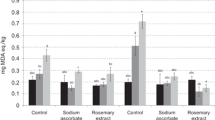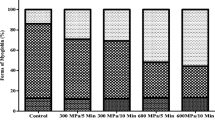Abstract
Formation of secondary lipid oxidation products during chill storage of vacuum-packed (99% vacuum), pressure-treated turkey thigh muscle was found to depend on working pressure (pressure range up to 500 MPa at 10°C) and to a lesser degree on pressurization time (10 and 30 min). Pressure treatment at 400 MPa and lower pressures for 30 min (and for 10 min) resulted in less formation of thiobarbituric-acid-reactive substances (TBARS) during 6 days of storage at 5°C compared to heat treatment at 100°C for 10 min, while pressure treatment at 500 MPa for 30 min gave similar development of TBARS as did the heat treatment. The formation of TBARS during storage at 5°C was found to depend exponentially on the pressure used for treatment at both 10 min and 30 min, and apparent volumes of activation are proposed as a parameter for quantification of the effects of pressure on lipid oxidation in meat during subsequent storage.
Similar content being viewed by others
Author information
Authors and Affiliations
Additional information
Received: 18 November 1996
Rights and permissions
About this article
Cite this article
Dissing, J., Bruun-Jensen, L. & Skibsted, L. Effect of high-pressure treatment on lipid oxidation in turkey thigh muscle during chill storage. Z Lebensm Unters Forsch 205, 11–13 (1997). https://doi.org/10.1007/s002170050115
Issue Date:
DOI: https://doi.org/10.1007/s002170050115




